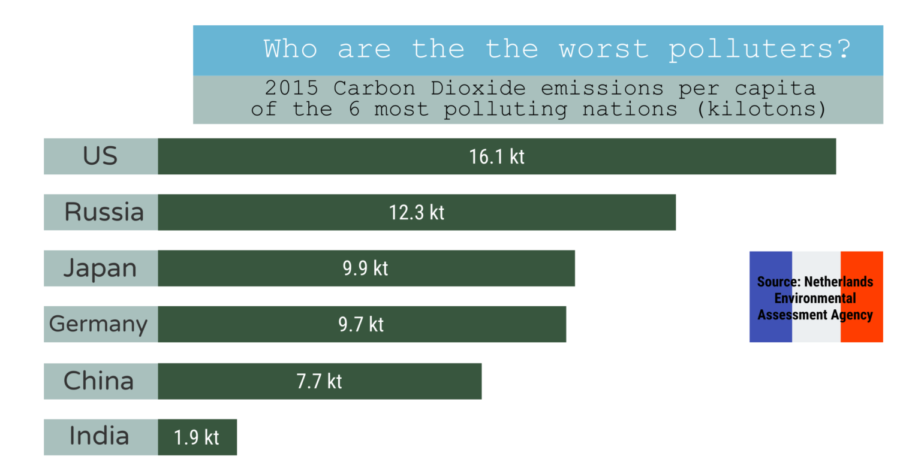Trump is out, but The Urban School joins the Paris Agreement
Infographic of Carob Dioxide emissions per capita of the most polluting countries.
The Urban School will become the first high school in the United States to join the “We Are Still In” declaration. When Donald Trump withdrew the United States from the Paris Agreement on June 1, 2017, climate change believers nationwide were ready to stay the course even if their leader would not. Four days later, the “We Are Still In” declaration was created by a variety of American environmental interest groups, urging Americans to self-enforce the Paris agreement.
The Paris Agreement of 2015 was the first worldwide effort to bring every nation to the table to discuss how to prevent the global temperature from rising an additional 2 degrees Celsius.
According to the agreement, “Each party shall prepare, communicate and maintain successive nationally determined contributions [NDCs] … [which] represent a progression beyond the Party’s then current nationally determined contribution and reflect its highest possible ambition.” In short, each country can set its own goals.
Head of the Urban School Mark Salkind said, “[The “We Are Still In” declaration] is saying despite the fact that President Trump pulled the [United States] out of [the Paris Agreement] framework, these organizations, these cities, these states, these universities, are still committed to meeting those targets … It’s consistent with [Urban’s] environmental values and beliefs.”
As of November 2017, California is one of nine states and San Francisco is one of 243 cities that have joined the pledge. The entirely Democratic state government and liberal city government mean the Urban School is already environmentally regulated.
“The US said that under Paris it will have a 26 [percent to] 28 percent reduction in carbon emissions by 2025 compared to 2005, that is a pretty substantial emissions cut,” said Academic Dean Geoff Ruth, who originally suggested that the Urban School join the “We Are Still In” declaration.
Beyond its 2025 goal of reducing greenhouse gas emissions by 26 percent, the United States’ goal before President Trump was to cut carbon emissions by 80 percent or more by 2050. To achieve these goals, former President Barack Obama instituted several programs via the Environmental Protection Agency and Department of Energy.
A key example was the 2015 Clean Power Plan to reduce carbon emissions from energy production by 30% by 2025. President Trump signed an executive order earlier this year demanding the EPA review the Clean Power Plan. In October, Reuters obtained documents suggesting that the EPA intends to scrap the plan altogether.
“California has adopted even more stringent emissions targets, so just by being an organization in California, [The Urban School is] already subject to those emissions targets,” Ruth said.
California is set to cut emissions by 40 percent by 2030 compared to 1990 levels.
An example of California’s ambitious efforts to reduce emissions is its Cap and Trade program. The program gives companies permits for greenhouse gas emissions. If companies wish to exceed their permits, they need to buy more permits from the state or companies who have not exceeded their permits. Another example is the expansion of Title 24 California building requirements to curb energy use.
“When we built this new building, there were new Title 24 electrical requirements to put in the lights, the lights are governed by sensors, and the sensors have defaults. So you can’t make them brighter than a certain level, even on a cloudy day. As you go forward you will see more Title 24 electrical requirements that will reduce electrical use by 50% by 2030,” Salkind said.
That is not to say that the Urban School is just obeying the law by participating in the pledge. Urban has a history of exceptional environmental consciousness.
“Urban has been the first school [in the country] to receive a LEED EBOM (Existing Buildings: Operations and Maintenance) rating … The Mark Salkind center will get a LEED Gold rating for its design,” Salkind said. LEED (Leadership in Energy and Environmental Design) is a US-based system to rate buildings on their sustainability and encourage green development practices.
“We’re looking at changing our lights to LEDs instead of fluorescent tubes. We’re looking at changing the glass to reflect more heat and require less energy to cool the building. We’re looking at expanding our photovoltaic array,” Ruth said.
“At some point in the near future, we will be replacing the HVAC (Heating Ventilation Air Circulation) units on the roof. They are really old units and they are really inefficient,” Salkind said.
As for what members of The Urban School community can do to help combat climate change, Ruth put it succinctly: “Eat less meat.”


